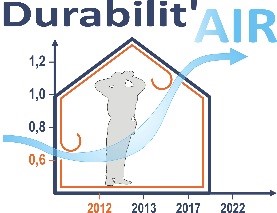R&D RESCOLL : DURABILIT’AIR, a research project on durability of airtightness products
Rescoll’Blog / 22 octobre 2019 First results from a literature review, preparing a field measurement campaign and a laboratory protocol for airtightness accelerated aging and performance characterization.
First results from a literature review, preparing a field measurement campaign and a laboratory protocol for airtightness accelerated aging and performance characterization.
Over the past thirty years, much progress has been made to increase knowledge about mechanisms governing building airtightness and the impact of air infiltrations on energy efficiency, health effects and construction quality related issues. As a matter of fact, since the early 2000’s, regulations in many countries explicitly account for airtightness, sometimes with mandatory requirements, as a consequence of Europe’s ambition to generalize nearly zero energy buildings by the end of 2020. Nevertheless, less expertise is available today about the durability of airtightness products, in mid- and long-term scales. Indeed, this subject remains very complex, since it covers both the modelling of the mechanisms of building’s and products’ loads and deformations, the accelerated aging in laboratory controlled conditions and the performance characterization from field measurements results.
With the DURABILIT’AIR research project, Cerema, PLEIAQ, CETII and RESCOLL aim at improving knowledge on various questions related to residential buildings envelope airtightness durability. This 36 month project has 4 major objectives:
- listing the major international research findings dealing with airtightness durability of building products, through a state of the art review,
- characterizing the evolution over time of the airtightness of existing single family dwellings by on site measurement campaigns
- understanding and modelling the physical mechanisms causing the airtightness performance degradation as a function of time with a view to develop laboratory controlled methods in order to test the accelerated aging of airtightness sensitive products and systems
- disseminating the main results of this work, with tools and communications among professional of the building sector in order to promote best practices
First Results from a Literature Review
PLEIAQ summarised a collective literature review with the major recent published findings on airtightness durability from field measurement studies and laboratory tests. Namely, the variation of the airtightness is found to be qualitatively caused by (1) the building’s occupants actions (refurbishment and internal decoration) ; (2) the aging and degradation of airtightness products ; (3) the structure movements (e.g. settlement) ; (4) the humidity variation. Furthermore, the main results of this review are the following :
- Results of 4 field measurement campaigns have been analysed (samples varying from 6 to 17 buildings), by comparing infiltration airflow rates measurements evolution between dates varying from 1 to 20 years. Infiltration airflow rates appear to increase during the first three years after the construction (in the order of 10-15%), before stabilizing.
- Results from 5 field measurements studies highlight possible correlation between the infiltration airflow rates evolution with the seasons of the year and the constructive type.
- No standardized protocol for accelerated aging and testing of airtightness products is available. Results from 7 studies present different experimental protocols, based on specific extreme heating and relative humidity conditions and pressure loads.
Future Works
Two field measurement campaigns have started in September 2016, led respectively by Cerema and CETII. They aim at assessing the evolution of the measured airtightness in 2 samples of 30 single family French dwellings in a long-term perspective (i.e., evolution of the airtightness after 5 to 10 years comparative measurements) and mid-term perspective (evolution after less than 3 years comparative measurements). Additional measurements will explore the seasonal influence.
In the meantime, an experimental laboratory protocol is currently designed by RESCOLL and Cerema, in order to develop an accelerated airtightness aging tests for 3 samples of airtightness constructive solutions with representative assembled products.
Assemblage par collage • eco-innovation • études techniques • GREEN POWER